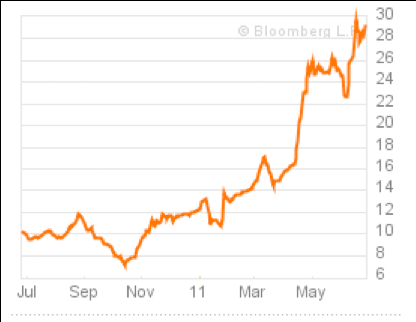|
||||||||||||||||||||||||||||||||||||||||||||||||||||||||||||||||||
|
||||||||||||||||||||||||||||||||||||||||||||||||||||||||||||||||||
June 7: |
"The Approaching Spanish Repudiation" | |
July 5: |
"[Spain] Making Arrangements for the Payment of Current Coupon" | |
August 2: |
"Spanish Interest Will Not Be Paid" | |
August 30: |
"Anarchy in Spain" |
The Argentine crisis of 2001 was documented by headlines from a number of publications. It is worth noting that as late as June there was confidence "Appetite for Credit Risk has Improved Considerably".
July 18, 2001: |
"Markets Laud Argentine Debt Accord – Calms Fears of Default" | |
August 3, 2001: |
"Flurry of International Contacts to Prevent [Argentina] Default" | |
December 14-20, 2001: |
"Angry Argentines Take Their Displeasure to the Streets" | |
| "State of Siege" | ||
| "Looters Ravage Cities" |
There seems to be a common pattern on the transit from confidence to dismay, and it will be interesting to see how it works out this time around. The distinction is that the 1873 example included many countries and as the historian, S.G. Checkland, wrote "Many half barbarous states pressed eagerly for funds, and spent them with no display of wisdom."
The Argentine problem in 2001 was not accompanied by insolvencies in a number of countries.
However, there is no question that the 1930s disaster in all lower-grade debt was part of a massive post-bubble contraction. It was reviewed in Foreign Bonds: An Autopsy, a rather appropriate title, published by Howland Swain Company in 1933:
"The fiscal history of Latin America … is replete with instances of governmental default. Borrowing and default follow each other with almost perfect regularity. When payment is resumed, the past is easily forgotten and a new borrowing orgy ensues. This process started at the beginning of this past century and has continued down to this present day. It has taught nothing."
How bad can it get? Typically the post-bubble contraction afflicts all aspects of the financial markets – including sovereign debt. The process is devastating and continues until both lenders and borrowers vow to never be reckless again.
***
Sovereign Follies
2010: |
||
January 14: |
"Greece Unveils Stability Program" | |
January 21: |
"Investors are concerned that Greece won't be able to finance its budget deficit." | |
February 14: |
"Years of unrestrained spending, cheap lending and failure to implement reform." | |
February 17: |
"Greek Tragedy Averted, For Now" | |
February 24: |
"Greek Police, Protesters Clash" | |
April 11: |
"Emergency Aid Approved" | |
August 10: |
"Greek Debt Crisis Finally Over" | |
August 10: |
"Greece is one part of the crisis and it has faded from the headlines." | |
2011: |
||
May 29: |
"Thousands of protestors denounce Greece's entire ruling class." | |
June 28: |
"Greek Debt Crisis Leads to Mass Strike" | |
June 28: |
"Greece Faces 'Suicide' Vote on Austerity" | |
"Bankruptcies of governments have, on the whole, done less harm to mankind than their ability to raise loans." – Prof. R.H. Tawney, Religion And The Rise Of Capitalism, 1926
Two-Year Greek Government Notes

• August 10, 2010: "Greek Debt Crisis Finally Over": Yield 9%.
• June 28, 2011: "Greece Faces 'Suicide' Vote on Austerity": Yield 30%.
###
-Bob Hoye
Institutional Advisors
email: bobhoye@institutionaladvisors.com
website: www.institutionaladvisors.com
Hoye Archives
The opinions
in this report are solely those of the author. The information
herein was obtained from various sources; however we do not guarantee
its accuracy or completeness. This research report is prepared
for general circulation and is circulated for general information
only. It does not have regard to the specific investment objectives,
financial situation and the particular needs of any specific person
who may receive this report. Investors should seek financial advice
regarding the appropriateness of investing in any securities or
investment strategies discussed or recommended in this report
and should understand that statements regarding future prospects
may not be realized.
Investors should note that income from such
securities, if any, may fluctuate and that each security's price
or value may rise or fall. Accordingly, investors may receive
back less than originally invested. Past performance is not necessarily
a guide to future performance. Neither the information nor any opinion expressed constitutes
an offer to buy or sell any securities or options or futures contracts.
Foreign currency rates of exchange may adversely affect the value,
price or income of any security or related investment mentioned
in this report. In addition, investors in securities such as ADRs,
whose values are influenced by the currency of the underlying
security, effectively assume currency risk. Moreover, from time to time, members of the Institutional Advisors team may be long or short positions discussed in our publications.

